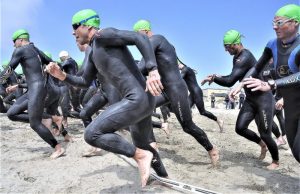Rhythmic gymnastics
Rhythmic gymnastics is a game exclusively for women in which gymnasts perform on a concrete floor using different objects such as ropes, hoops, balls or ribbons, accompanied by music, either in groups or individually. This activity is the perfect combination of sport and art, connecting expressive dance steps with different skills and movements. Rhythmic gymnastics is suitable for women and girls of all ages. It is an excellent way to increase confidence and creative skills.

Related topics
Aerobic gymnastics, artistic gymnastics
What is rhythmic gymnastics?
Rhythmic gymnastics is a sport practiced by women in which sport, art and dance are combined through different skills and movements and using a series of instruments such as ropes, hoops, ribbons and balls to give it an aesthetic sense.
About rhythmic gymnastics
Rhythmic gymnastics includes many deep aspects as well as dancing, the gymnast has to perform various movements such as jumping, spinning and dancing, all while manipulating and throwing different equipment, everything according to the music’ rhythm. It’s not easy, but rhythmic gymnasts have to make it seem like an easy job.
Rhythmic gymnastics history
Rhythmic gymnastics is a sport that originated during the 1930s in the Soviet Union, however, there is evidence that this type of sport was born in the eighteenth century and that was practiced in Western Europe. Over the years, it has evolved and improved enormously, until, in 1984, it was declared an Olympic sport, establishing rules and foundations for its practice.
Movements
The movements performed in this sport are the basis of it and can be performed in different directions always using the harmonious movements with the rhythm of the music. Some of the most common movements are:
- Jumps: you must have good amplitude and coordination, stride, Cossack, arched, are some types of jumps that are practiced in the discipline.
- Equilibrium: in this movement the athlete must acquire a fully balanced position and remain in it for at least two minutes. It can be the horizontal balance, the passé, the penché, etc.
- Turns: these are known as rotations and can be made with the foot in a flat position, with half a point or with some other part of the body.
- Waves: are performed with the support of one or both feet and have their degree of difficulty.
Rules of rhythmic gymnastics
The rules of rhythmic gymnastics will depend on the type of movement that is being executed, this way we can mention the following:
Jumps and hops
- All jumps must have a good height, have a clear shape and good amplitude.
- All jumps with an arched back must keep the head in contact with the leg.
Balances
- Balances should be done with the toes and/or the knee. They must be clear movements and have a good fixed shape.
Pivots
- The different pivot combinations must be carried out completely with the toes without using the heel as a support.
Devices and equipment
In rhythmic gymnastics there are several instruments or equipment that can be used to develop routines, among them we can mention the following:
- Rope: this must be made of a lightweight material and quite flexible, can be made of hemp or some kind of synthetic material, is generally used to jump, and rope jumps can be added to shots, circles, rotations and figures of eight.
- Hoop: the hoops are made of plastic and in some occasions of wood; the turns are used making them turn around the hand or the body and they can be combined with circular movements, figures of eight, strips, ribbons, it is possible to pass over the hoop doing different types of movements.
- Ball: balls or balls are made of rubber or synthetic material, usually measuring between 18 and 20 centimeters in diameter, the balls are used in the hands, giving different types of movement and adding twists, shots, rebounds or rolls.
- Sticks or canes are made of wood or synthetic material; use canes to play to the rhythm of music and then add small mills and circles, asymmetrical movements, pitches and catches.
- Ribbons: they are approximately 6 meters long and this is probably the most popular event for spectators; the ribbon is used for fluid and large movements, to make spirals, circles and snakes.
- Hands Free: This is the type of rhythmic gymnastics that is done without any kind of apparatus; the emphasis is on style, technique and execution of dance skills.
How to cite this article?
Briceño V., Gabriela. (2019). Rhythmic gymnastics. Recovered on 24 February, 2024, de Euston96: https://www.euston96.com/en/rhythmic-gymnastics/









